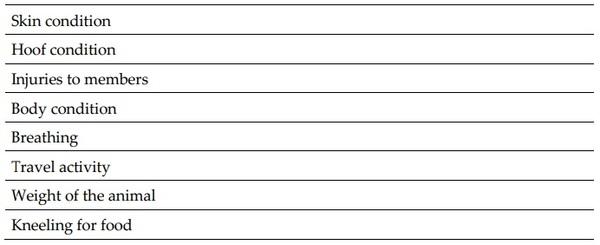Identification and validation of operational welfare indicators appropriate for small-scale goat farming in Chile
Published: May 7, 2021
By: Jaqueline Rodriguez 1, Mario Morales 2 and Hernan Cañon-Jones 1. / 1 Núcleo de Investigación Aplicada en Ciencias Veterinarias y Agronómicas, Facultad de Medicina
Veterinaria y Agronomía, Universidad de Las Américas, Chile; 2 Programa de Desarrollo Local, Instituto de Desarrollo Agropecuario e Ilustre Municipalidad de Lampa, Lampa, Chile.
Summary
Goat production in Chile is carried by small-scale farmers obtaining milk and cheese as the main products. The welfare of goats under these type of production systems is currently unknown and no appropriate validated operational welfare indicators are currently available. We took the tasks of identify operational welfare indicators and validate them with all stakeholders. A total of 37 operational welfare indicators were obtained. The use of these validated indicators and the welfare score is appropriate to Chilean goat production systems and may successfully increase the sustainability of production and farmers in Chile.
Keywords: behaviour; sustainable; value-added; appropriate; welfare.
1. Introduction
Goat production in Chile is carried out by poor small-scale farmers in semi-arid to arid agricultural conditions [1]. Milk and cheese are the main products obtained using artisanal, cultural and traditionally preserved methods where women and children are usually in charge of production [2]. The products are directly consumed by the family or sold to by-passers at good prices [3]. These production systems are similar in goat production around the world, especially in developing countries in the Americas and Africa.
Goats are adapted to higher temperatures and may seem a suitable and sustainable animal production under current global warming status in some areas of the world [4–6]. The welfare of production animals including goats has been increasing in recent years both for milk and meat goat production systems [7,8]. Numerous studies have been carried out identifying potential welfare indicators for goats. Some on-farm goat welfare assessments based on qualitative and quantitative variables have been developed for intensive systems in Europe [9,10]. However, goat welfare under extensive systems in semi-arid Chile is currently unknown and no appropriate validated operational welfare indicators are currently available. The incorporation of welfare assessment system may increase milk yield and cheese production, and may provide an extra added-value as in other countries [8,11]. The aim of this work was to obtain appropriate operational welfare indicators (AOWI) for small goat farmers in Chile.
2. Materials and Methods
We first identified all possible goat welfare indicators described in the scientific literature by searching in databases such as Scopus, Web of Science, Scielo, Pubmed. The welfare indicators were categorized as either direct or indirect and a tabulated accordingly.
We then followed the guidelines of the European Food Safety Agency to validate the indicators with the relevant stakeholders [12]. Briefly, hazard analysis and critical control point methodology is used to validate indicators with the relevant stakeholder which included farmers, staff working with goats, veterinarians and animal welfare experts. A questionnaire was constructed in which each stakeholder ad to evaluate the identified indicator for its perceived impact of animal welfare (magnitude) and its perceived easiness to measure (operational effectiveness) using a liker scale (0 to 5). Any indicator with 60% of approval was considered to validated by stakeholders,
A further on-farm real validation using the selected indicators was carried out to ensure their practicability and easiness of measure using a liker scale from 1 to 5. This was done in 4 different farms and in 5 different times. All indicators that had a score of 60% or more were finally classified as appropriate operational welfare indicator (AOWI).
All national and institutional ethical recommendations and guidelines were followed in order to preserved ethical integrity during the study.
Using the AOWI, we implemented a Goat Welfare Score system ranging from 0 to 100% of welfare, using a linear model where each indicator had a different weight according to the hazard analysis.
3. Results
We identified 48 welfare indicators in the peer-review literature. Only 40 of the initial welfare indicators were validated by goat production stakeholders (farmers, veterinarians, technician, welfare experts) using the European Food Safety Agency guidelines. After the on-farm validation, 33 operational welfare indicators were obtained (Supplementary material). A welfare score system was developed including all indicators and validated in normal production conditions.


4. Discussion
Our study showed that not all welfare indicators are well suited for different production system worldwide. Our study eliminated 32% indicators that were identified in the scientific literature, indicating that some of them are either not practical in normal production conditions or that stakeholders do not know them. This is important considering the local, economic and educational level of farmers in every country or territory. Furthermore, a deeper analysis shows that even after validation by stakeholders, some indicators failed to be practical or operational. These results showed the relevance of incorporating the actual farmers, technical staff and field veterinarians, into the validations of welfare indicators rather than keep the validation at an academic level exclusively. The use of these validated indicators and the welfare score are appropriate to the local Chilean goat production systems and may successfully increase the sustainability of production and farmers in Chile. Further studies should be focus on the temporal measurements of the AOWI and modifications to the mathematical welfare score system developed here.
This article was originally published in Proceedings 2020, 4. This is an Open Access article under the terms and conditions of the Creative Commons Attribution (CC BY) License (http://creativecommons.org/licenses/by/4.0/).
Related topics
Authors:
Influencers who recommended :
Hassan KhanJoin to be able to comment.
Once you join Engormix, you will be able to participate in all content and forums.
* Required information
Would you like to discuss another topic? Create a new post to engage with experts in the community.
Create a post




.jpg&w=3840&q=75)